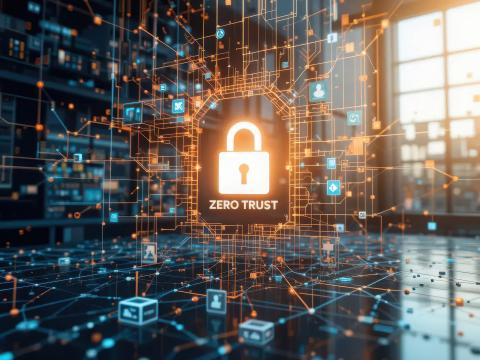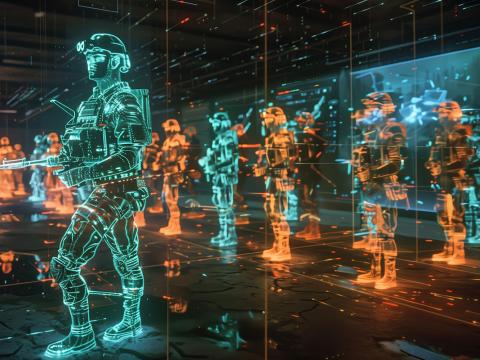Remote Work Is Here to Stay— So Is DoD's Broader Digital Revolution: Sponsored Content
To succeed in its digital transformation, with security always at the forefront, DoD needs the following five capabilities.
When the pandemic struck last year, the Department of Defense directed many employees to stay home to help prevent the spread of disease and protect its workforce. The scale and speed of the transformation to remote teleworking was breathtaking. DoD had to massively ramp up bandwidth and deploy collaboration tools to millions of users across its global network within weeks—it was an accelerated march to the cloud.
On an average day before the mid-March 2020 lockdown, up to 90,000 people were teleworking across the department, former DoD Chief Information Officer (CIO) Dana Deasy said last year. Within 10 weeks, that number had ballooned to 1.2 million. The 11-fold-plus growth was made possible by the roll-out of a new COTS cloud environment — “commercial virtual remote” or CVR.
“The reaction to the lockdown was immediate,” recalls Don Turner, Senior Product Manager with Avaya, “It was: ‘I just need people to be able to work from somewhere else! I need communication and remote collaboration tools.’ And frankly, some other considerations like security had to take a back seat for a while.”
Deploying new IT capabilities always involves risk management: Weighing the benefits of new tools against the expanded attack surface they may present, for instance. But the pandemic upended conventional risk management calculations because without remote collaboration capability—at least at the unclassified level—DoD’s workforce would simply be unable to fulfill their mission. So, they did the best they could under the circumstances to understand and accept some cybersecurity risk for mission assurance and continued to close cybersecurity gaps as they progressed.
And remember, unclassified doesn’t mean unimportant. Napoleon famously declared that an army marches on its stomach, and the work that keeps U.S. troops fed and watered, and supplies them with gasoline, munition and spare parts is conducted largely over unclassified systems.
So CVR was rolled out and declared secure up to DoD Impact Level 2 (uncontrolled unclassified information), even though it used a username and password logon rather than the stronger authentication generally required by DoD systems. A temporary exception was granted to get the system deployed until stronger measures could be put in place.
The crisis also pushed the fast-forward button on cultural and institutional changes already underway in DoD—speeding a transformation in the way the department thinks about, buys and uses technology. Projects and upgrades that would have normally taken months or years to plan and implement were instead rolled out in weeks.
No turning back
DoD occupied this new technology territory at blitzkrieg speed and has no plans to withdraw: “There will be some permanency to what we have here,” promised Deasy. Indeed, the department’s IT leaders are committed to expanding remote teleworking capabilities to higher information impact levels and to reach more users.
In its latest three-year strategic plan, the Defense Information Systems Agency (DISA) made telework and cybersecurity tools top priorities for 2021. Steve Wallace, Systems Innovation Scientist for DISA’s Emerging Technology Directorate, shared at AFCEA’s TechNet Cyber conference in December that the agency was looking to provide teleworking solutions that could even provide remote access to classified data.
And it’s not just work from home that’s here to stay. There’s a much broader digital transformation that the pandemic lockdown accelerated—and that will require some profound changes in DoD IT.
“The requirement going forward and in the modern world is that we can securely move any information from anywhere to anywhere,” declared Navy CIO, Aaron Weis. He further stated, “That is a baseline requirement going forward. And, while that sounds very simple to say, that’s not how our infrastructure and our networks are organized today.”
There’s no turning back. “The new normal is coming,” predicts retired Navy rear admiral and former Navy Cybersecurity Director Danelle Barrett, “Obviously far fewer will be working from home, but the pandemic crisis put the final nail in the coffin of the network perimeter as the basis for cybersecurity. As DoD moves towards a zero trust cybersecurity model, the data that it must protect is shared across an increasingly complex hybrid environment: From multiple clouds to legacy databases, on-premises systems, Internet of Things (IoT) endpoints, operational technology systems and new autonomous vehicle platforms. DoD needs to have the right people, the right processes and the right technology baked in — you can’t sprinkle it on top afterwards.”
DoD’s digital transformation must succeed
To realize the vision of getting data “from anywhere to anywhere,” DoD will have to reimagine its IT architecture—embracing an open standards-based approach, not just to hardware and software, but to IT services as well.
The complex, hybrid IT environment in which DoD elements must meet their mission requires cloud-based services from different vendors to play nicely with each other, just as their hardware and software products have to do. “It’s not all going to come from one provider,” notes Turner. For multivendor IT environments to work, the DoD has to set and enforce standards to ensure interoperability. “Standards enable DoD to deploy new capabilities, and scale them rapidly, with the confidence they can integrate with existing tools, platforms and devices,” he says.
DISA has led the way, publishing both a cloud security requirements guide, and a cloud connection process guide—setting standards that cloud services must meet.
With those standards in place across the DoD enterprise, cloud-to-cloud services like Avaya’s OneCloud Secure can reach out across the department’s networks to get the unclassified data its workforce needs to execute the mission. “We can obtain that data, extract that data, share that data, make it securely available to the people that need it on any device, over any network,” says Turner.
But, as massive in scale and speed as it is, the work from home revolution is still only one piece of the digital transformation that the department is undertaking.
Joint All Domain Command and Control, or JADC2, is the DoD-wide IT architecture needed to realize the vision of a networked joint force able to operate at 21st century speed. Traditionally, combat forces have been commanded through service stovepipes—an Air Operations Center deploys Air Force assets, for instance. JADC2 seeks to eliminate those stovepipes in favor of a totally integrated and truly networked force—capable of connecting any shooter or sensor to any field commander at any time. Preston Dunlap, Chief Data Architect for the Air Force, has called it “The Internet of Military Things.”
To achieve these quantum leaps in interoperability, the JADC2 vision requires, like the work from home revolution, a new approach to infrastructure, says Barrett. ‘You can’t take the plumbing for granted,” she says, “At the pointy end of the spear, you’re going to be drinking from a straw, not a firehose. New sensors, autonomous vehicles, all require data or produce data. You have to think about how you standardize and tag that data, how you move that data, back to headquarters, out to the tactical edge, to the shooter. Where is that bandwidth coming from? Data needs to be planned and managed in the context of available transport to move it where it needs to be for mission success.”
To succeed in its digital transformation, with security always at the forefront, DoD needs the following five capabilities:
Multivendor Solutions—Embracing interoperability of existing investments by adherence to industry open standards solutions. DoD needs to adhere to open standards-compliant products to improve their agility in switching between commercially provided solutions that meet those standards as operational requirements change.
Situational Awareness—DoD managers need presence and availability information about their newly remote workforce to enable real-time management. Leaders also need to be able to visualize different aspects of business and operations. Dashboards correlate data into predictive and comprehensive “views” based on the user’s role—aiding decision making.
Speed, Scalability, and Capacity—Having the flexibility to easily consume resources as needed. Increasingly, the DoD needs to buy capability as a service. “It’s not about just buying a box anymore,” says Barrett. Buying a service means you get the people and processes that make the technology work—and keep it on the leading edge without costly re-engineering or integration.
Automation—Enabling Artificial Intelligence (AI) to quickly deliver services, increase productivity, and reduce resource requirements. Use of AI in automation for everything from readiness and operations to cybersecurity will improve the speed and accuracy of mission accomplishment.
Omnichannel Notification—Driving engagement regardless of device or location. This includes the complex addition of IoT, robotics, and autonomous and unmanned vehicles into the architecture to enable future capabilities.
The future is now—the vision of a networked force
If the pandemic has taught us nothing else, we have learned that, in times of crisis, few things are more important to ensuring mission success than the ability to communicate.
As DoD moves ahead with its digital transformation, it must learn those lessons well—and apply them in its new vision across both the business enterprise and operational networks.
Join AFCEA for a webinar on April 1, 2021 at 11:00 AM EST, titled “Ensuring Mission Success & Safety in a Dispersed Work Environment: Maximizing the Power of Unified Communications (UC).” Learn how organizations have overcome challenges and delivered the resources and tools needed to successfully accomplish their mission. Moderator and panelists will include:
Rear Adm. Danelle Barrett, USN (Ret.) - Moderator
Brig. Gen. Lorna Mahlock, USMC, director, IC4 (Information, Command, Control, Communications, and Computers) and Deputy of the Navy CIO - Panelist
Rear Adm. Doug Small, Commander, USN, NAVWAR (Naval Information Warfare Systems Command) - Panelist
Josh Reiter, Director, Information Warfare Manpower and Integration at U.S. Navy - Panelist
Don Turner, Senior Product Management – Avaya Government Solutions – Panelist
Webinar Registration: https://www.workcast.com/register?cpak=7967187451636920
Chris Miller (Miller78@Avaya.com) (703) 376-2011 • www.avaya.com




Comments